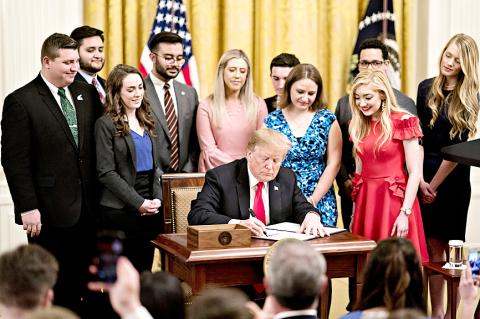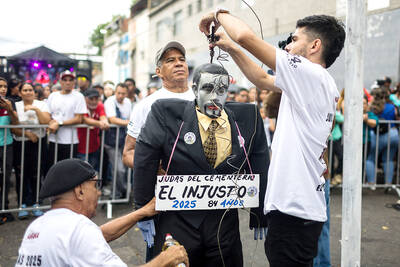US President Donald Trump on Thursday signed an executive order requiring US colleges to protect free speech on their campuses or risk losing federal research funding.
The order directs federal agencies to ensure that any college or university receiving research grants agrees to promote free speech and the exchange of ideas, and to follow federal rules guiding free expression.
“Even as universities have received billions and billions of [US] dollars from taxpayers, many have become increasingly hostile to free speech and to the first amendment,” Trump said at a White House signing ceremony. “These universities have tried to restrict free thought, impose total conformity and shut down the voices of great young Americans.”

Photo: Bloomberg
The order follows a growing chorus of complaints from conservatives who say their voices have been stifled on campuses across the US. Joining Trump at the ceremony were students who said they were challenged by their colleges while trying to express views against abortion or in support of their faith.
Trump initially proposed the idea during a March 2 speech, highlighting the case of Hayden Williams, who was punched in the face while recruiting for the group Turning Point USA at the University of California, Berkeley.
He invoked the case again on Thursday, saying that Williams was hit hard, “but he didn’t go down.”
Under the order, colleges would need to agree to protect free speech to tap into more than US$35 billion a year in research and educational grants.
For public universities, that means vowing to uphold the first amendment of the US constitution, which they are already required to do. Private universities, which have more flexibility in limiting speech, will be required to commit to their own institutional rules.
“We will not stand idly by to allow public institutions to violate their students’ constitutional rights,” Trump said. “If a college or university doesn’t allow you to speak, we will not give them money. It’s very simple.”
Enforcement of the order will be left to federal agencies that award grants, but how institutes would be monitored and what types of violations could trigger a loss of funding have yet to be seen.
White House officials said details about the implementation would be finalized in the next few months.
Many colleges have firmly opposed the need for an executive order.
Following Trump’s speech, Janet Napolitano, president of the University of California, said that many are “ground zero” for the exchange of ideas.
“We do not need the federal government to mandate what already exists: Our longstanding, unequivocal support for freedom of expression,” she said. “This executive order will only muddle policies surrounding free speech, while doing nothing to further the aim of the first amendment.”
The American Council on Education, which represents more than 1,700 college presidents, called the order “a solution in search of a problem.”
“No matter how this order is implemented, it is neither needed nor desirable, and could lead to unwanted federal micromanagement of the cutting-edge research that is critical to our nation’s continued vitality and global leadership,” said Ted Mitchell, the organization’s president.
US Secretary of Education Betsy DeVos focused on another part of the order dealing with transparency in college performance data.
Her statement said that students “should be empowered to pursue truth through the free exchange of all ideas, especially ideas with which they may not agree. Free inquiry is an essential feature of our democracy, and I applaud the president’s continued support for America’s students.”
The order was supported by conservative groups including Turning Point USA, which has pushed for action on the issue.
In Trump’s speech, he thanked Charlie Kirk, the group’s founder, who has pushed for action on the issue.
On Twitter, Kirk called the order “historic,” adding that while harassment by campus faculty is not uncommon, “it ends today!”

POLITICAL PRISONERS VS DEPORTEES: Venezuela’s prosecutor’s office slammed the call by El Salvador’s leader, accusing him of crimes against humanity Salvadoran President Nayib Bukele on Sunday proposed carrying out a prisoner swap with Venezuela, suggesting he would exchange Venezuelan deportees from the US his government has kept imprisoned for what he called “political prisoners” in Venezuela. In a post on X, directed at Venezuelan President Nicolas Maduro, Bukele listed off a number of family members of high-level opposition figures in Venezuela, journalists and activists detained during the South American government’s electoral crackdown last year. “The only reason they are imprisoned is for having opposed you and your electoral fraud,” he wrote to Maduro. “However, I want to propose a humanitarian agreement that

ECONOMIC WORRIES: The ruling PAP faces voters amid concerns that the city-state faces the possibility of a recession and job losses amid Washington’s tariffs Singapore yesterday finalized contestants for its general election on Saturday next week, with the ruling People’s Action Party (PAP) fielding 32 new candidates in the biggest refresh of the party that has ruled the city-state since independence in 1965. The move follows a pledge by Singaporean Prime Minister Lawrence Wong (黃循財), who took office last year and assumed the PAP leadership, to “bring in new blood, new ideas and new energy” to steer the country of 6 million people. His latest shake-up beats that of predecessors Lee Hsien Loong (李顯龍) and Goh Chok Tong (吳作棟), who replaced 24 and 11 politicians respectively

Young women standing idly around a park in Tokyo’s west suggest that a giant statue of Godzilla is not the only attraction for a record number of foreign tourists. Their faces lit by the cold glow of their phones, the women lining Okubo Park are evidence that sex tourism has developed as a dark flipside to the bustling Kabukicho nightlife district. Increasing numbers of foreign men are flocking to the area after seeing videos on social media. One of the women said that the area near Kabukicho, where Godzilla rumbles and belches smoke atop a cinema, has become a “real

‘WATER WARFARE’: A Pakistani official called India’s suspension of a 65-year-old treaty on the sharing of waters from the Indus River ‘a cowardly, illegal move’ Pakistan yesterday canceled visas for Indian nationals, closed its airspace for all Indian-owned or operated airlines, and suspended all trade with India, including to and from any third country. The retaliatory measures follow India’s decision to suspend visas for Pakistani nationals in the aftermath of a deadly attack by shooters in Kashmir that killed 26 people, mostly tourists. The rare attack on civilians shocked and outraged India and prompted calls for action against their country’s archenemy, Pakistan. New Delhi did not publicly produce evidence connecting the attack to its neighbor, but said it had “cross-border” links to Pakistan. Pakistan denied any connection to